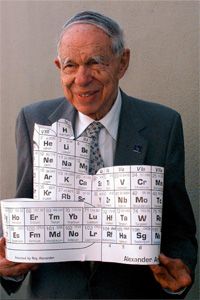IUPAC: The Gatekeeper of Elements
The International Union of Pure and Applied Chemistry (IUPAC) oversees the periodic table of elements, which, as of November 2011, consisted of 112 officially named elements, like seaborgium and regular old potassium.
An official element is one that was claimed to have been discovered, the discovery was verified and the element was named. An unofficial element is one that was claimed to have been discovered, but the claim has not been verified, so the element hasn't been named. One of the more recent elements to claim fame on the periodic table was roentgenium, which was unearthed in December 1994 and named after Wilhelm Roentgen, the scientist behind X-rays.
Advertisement
The last elements to be discovered had atomic numbers of 112, 114, 116 and 118. They are unofficially called ununbium (Uub), ununquadium (Uuq), ununhexium (Uuh) and ununoctium (Uuo), respectively -- Greek for the atomic numbers of these elements. There are spots in the periodic table for elements with atomic numbers 115 and 117, but these elements haven't been discovered, much like Mendeleyev left gaps in his table for elements that hadn't turned up yet. Of course, nothing in science is static, so it's always good to check with IUPAC if you're unsure about whether an element is official or not.
Ununquadium doesn't exactly roll off the tongue, so how does an element get a new title and achieve official status? And are there any naming restrictions? Is christening an element after a beloved pet strictly frowned upon, but after a hometown or lab location accepted?
Remember that the new elements are all radioactive ones that are made in particle accelerators and have short lives before they decay into another element. In addition, any new element discovered must have a lifetime greater than 10-14 seconds. Two difficulties exist in confirming these new elements: First, they're not produced in large quantities, and second, they don't last very long. That means it's a long, difficult road to verify the claim that a new element has been discovered. But the procedure for naming an element is as follows:
- The claim that a new element has been found must be published in the scientific literature.
- IUPAC analyzes the claim as to who discovered it (often competing labs claim discoveries of new elements), whether the experiments were valid and whether it meets the criteria for a new element. IUPAC publishes its analysis in its official journal Pure and Applied Chemistry in which it establishes who discovered the element and how it was made.
- The element gets a provisional Greek name and square in the periodic table.
- IUPAC invites the credited discoverers to submit a name and symbol for the new element drawn from a mythological concept, mineral, country or place, property or scientist.
- The proposal is publicly reviewed, usually by neutral scientists.
- IUPAC makes the final decision.
- IUPAC publishes the name in Pure and Applied Chemistry and adds it to the periodic table.
Many people have made different representations of the periodic table, such as spiral forms, 3-D forms, even a humorous "Periodic Table of the Elephants" that features a cartoon elephant with a slightly different take on the elements. For example, the helium block features an elephant balloon filled with helium and the beryllium block features a cold elephant -- Brrr-illium. Get it? Still, none of these twists on the periodic table have yet proved as useful as the standard form that you see in any chemistry textbook today.
If you're ravenous for more elemental reading, keep reading for links to articles on aluminum, lead and more next.
Related HowStuffWorks Articles
More Great Links
Sources
- Brown, T.L. et al. "Chemistry the Central Science," eighth edition. Prentice-Hall. 2002.
- Chemistry Daily, History of the Periodic Table. Jan. 4, 2007.http://www.chemistrydaily.com/chemistry/History_of_the_periodic_table
- IUPAC. "Naming of New Elements." Pure Appl. Chem. Vol. 74, No. 5, pp. 787-791 (2002).http://old.iupac.org/publications/pac/2002/7405/7405x0787.html
- IUPAC. "Criteria that must be satisfied for the discovery of the new chemical element to be recognized." Pure Appl. Chem., Vol. 63, No. 6, pp. 879-886, 1991. http://old.iupac.org/reports/1991/6306wapstra/index.html
- Kaesz, H. "The synthesis and naming of elements 110 and beyond." Chem Int vol. 24 No. 2 Mar 2002.http://old.iupac.org/publications/ci/2002/2402/elements110.html
- Tzimopoulos, N.D. et al. "Modern Chemistry," third edition. Holt Rinehart and Winston. 1990.
- Wilbraham, A.C. et al. "Chemistry." Prentice-Hall. 2008.
